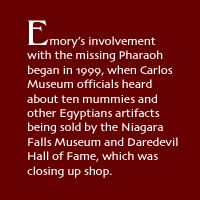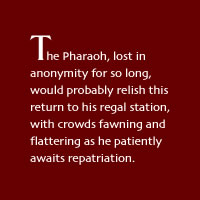The
unwrapped royal mummy, modestly draped with a linen cloth, lies
in a dim, quiet room on the third floor of the Michael C. Carlos
Museum, surrounded by screened reproductions of colorful tomb
paintings.
Groups
of schoolchildren are hushed as they file past the 3,000-year-old
Pharaoh, now thought by most scholars to be Ramesses I, founder
of one of Egypt’s most powerful dynasties, who ruled from
1293 to 1291 B.C.
After
years of study and conservation, the most famous mummy in the
museum’s collection is on view for the first time in
“Ramesses I—The Search for the Lost Pharaoh.”
After the exhibition concludes on September 14, the Egyptian
ruler will be returned to the Cairo Museum.
“This
shows that amazing discoveries in the most unlikely of places
are still to be made,” said Peter Lacovara, curator of
Ancient Egyptian, Nubian, and Near Eastern Art.
 Through
art and artifacts, site maps and photographs, and video and
computer imagery, the museum tells the tale of the mummy’s
adventurous route to Atlanta. Also on display are tomb treasures
and embalming equipment, granite sculptures of Pharaoh heads,
mummy bandages, and court transcripts on papyrus.
Through
art and artifacts, site maps and photographs, and video and
computer imagery, the museum tells the tale of the mummy’s
adventurous route to Atlanta. Also on display are tomb treasures
and embalming equipment, granite sculptures of Pharaoh heads,
mummy bandages, and court transcripts on papyrus.
Emory’s
involvement with the missing Pharaoh began in 1999, when Carlos
Museum officials heard about ten mummies and other Egyptian
artifacts being sold by the Niagara Falls Museum and Daredevil
Hall of Fame, which was closing up shop.
Rumor
had it that one of these mummies might be the long-lost remains
of Ramesses I, who was sold on the black market in Luxor in
the mid-nineteenth century after his tomb was raided.
After
Emory raised nearly two million dollars from the Atlanta community
to purchase the entire collection, the mummies, coffins, and
antiquities were moved to the Carlos Museum, where they were
restored and analyzed by conservators, Egyptologists, radiologists,
and geneticists. X-rays and CT scans were taken at Emory Hospital
to determine the age, gender, and identifying characteristics
of the mummies.
Evidence
started mounting that the five-foot-five-inch male, who came
without wrappings or coffin, was the missing nineteenth-dynasty
Pharaoh. While DNA tests were inconclusive, radiocarbon dating
placed the mummy’s origins in the right era, and his age
at death was determined to be in his sixties, which also fit
what was known about Ramesses I.
The
mummy’s arms are crossed over his chest, he has a large
amount of expensive molten resin in his skull, and his toes
are splayed – all characteristics signifying a mummy of
royal status.
Finally,
there is the striking family resemblance: the mummy has a slender
build, a prominent, hooked nose, a high forehead, and arched
feet. These traits are shared with Ramesses I’s son, Seti
I, and his grandson, Ramesses II (the Great), both of whom are
on display at the Cairo Museum. Photographs of Seti I’s
and Ramesses II’s remains are included in the Carlos exhibition
for comparison.
These
physical characteristics as well as many extra features, such
as a virtual “fly-through” inside the body of Ramesses
I, can be viewed on computer stations set up at the exhibit,
or at http://carlos.emory.edu/RAMESSES.
 Also
among the 145 objects the Carlos Museum purchased from the Niagara
Falls Museum were four small fragments of painted limestone
relief.
Also
among the 145 objects the Carlos Museum purchased from the Niagara
Falls Museum were four small fragments of painted limestone
relief.
When
the lot was unpacked and examined in Atlanta, the identity of
these fragments were immediately apparent to Lacovara. “I
had been to Seti I’s tomb and immediately recognized the
quality and type of painted relief,” said Lacovara, who
had plaster casts made of the fragments and brought them to
the tomb in Egypt himself to check their fit. “They were
a perfect match.”
In
April, under the guardianship of Zahi Hawass, general director
of Egypt’s Supreme Council on Antiquities, they were sent
back to be replaced in Seti’s tomb as part of a full-scale
restoration.
As
for Ramesses I, Delta Airlines has agreed to transport the mummy
to Paris where it will be transferred to an Egypt Air flight
to Cairo.
“It
is exciting to be collaborating more closely with our colleagues
in Egypt, to be moving toward the moment when we return the
mummy to the people of Egypt, and to share the exhibition with
visitors before its departure,” Lacovara said.
The Pharaoh, lost in anonymity for so long, would probably relish
this return to his regal station, with crowds fawning and flattering
as he patiently awaits repatriation.
“Look
at that!” said one elementary-aged student, standing on
tiptoe to peer inside the mummy’s mouth. “He’s
got pretty good teeth for such an old guy.”–M.J.L.
To
read more about the Return of the Mummy, go to: www.emory.edu/EMORY_MAGAZINE/autumn2002/enigma.html